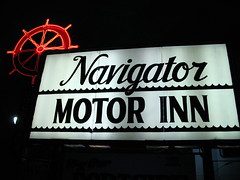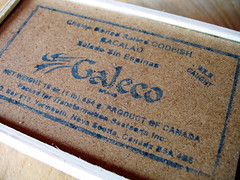
produced by Chotsie Blank and Ann Seymour
for the San Francisco Museum of Modern Art
(Abbeville Press, 1982).
(Abbeville Press, 1982).
I bought this because I wanted to see the Wayne Thiebauds in it. I've loved his work since I first encountered it at the Wadsworth Atheneum as a tiny kid on field trips. Although the images in this book are not of high quality (they scan nicer than they are in print) they're still fun to look at.

At the time of publication this one was apparently in Thiebaud's own collection, but now it's at the National Gallery of Art in Washington.


There's lots of other great art in the book. This painting by Paul Wonner is probably my favorite:

The carnivorous among you (and a certain portion of the anti-carnivorous?) may prefer Marianne Boers's still-life with Safeway meats:

Her "Royal Baking Powder" (which is not in the book) is a similar work of supermarket photorealism but dark and metallic rather than pastel and fleshy.
There are also over 200 recipes, and they are far more interesting than the type usually found in let's-collect-recipes-from-friends cookbooks. I didn't spot any that appeared to have been lifted from the back of a bag or the side of a can, and a great many of them are inventive and unusual. You are not likely to be served painter Penelope Fried's preparation of mangoes for reflective moments, for example, by anyone but Penelope Fried:

I flagged quite a few recipes I wanted to try. Painter Rooney O'Neill's recipe for penne strascicate appealed to me right away because of its simplicity and reliance on well-chosen ingredients. I also liked her admonition not to serve grated cheese with the dish; it's a sign that the recipe did in fact come from a good, strict Italian cook who is confident in their way with pasta and won't stand for any interference with the flavors they intend it to have.


I am happy to report that the recipe is indeed a keeper; the acidic canned plum tomatoes and the crème fraîche come together beautifully. I used only 1/4 cup of olive oil because I thought any more than that would just end up in little puddles around the edges of the pan. I was also a little concerned the tomatoes wouldn't break down enough while the sauce was cooking so I took a wooden spoon to the most stubborn ones as they simmered, and by the end of the 30 minutes I had a very nice sauce — fresh-tasting and just rich enough — that didn't need to be puréed.
Gerald Gooch's recipe for creamy sunflower dressing turned me into the sort of hippie who goes and buys a bottle of Bragg's Aminos (not to be confused with Dr. Bronner's, although both have word-soup packaging). There must be some sort gateway hippie substance among the aminos because I am now also happily drinking a little of their apple cider vinegar every day.


This dressing is GOOD. It's creamy and tangy and the flavor is really well-balanced. In the photo above it was used in a baked tofu wrap; it was terrific on simple green salads too. I was suspicious of the recipe because of the water content and because it doesn't call for much in the way of spices, but I am definitely going to be making it again often. Maybe it's the serotonin produced by the sprouts talking, but I think this dressing is good enough to please even people who claim to hate hippie health-food-store type foods. And possibly even children, though I don't have any to test it on. I didn't even use all the oil the recipe calls for (I ran out after 1 1/3 cups) and it was still delicious. I also had no parsley so I used celery leaves instead, and that didn't hurt it at all. Note, however, that the recipe makes an enormous quantity of dressing, so you might want to try halving it, or inviting all the local beard-wearers and spinners of lumpen pottery over to share it with you.
You can buy sprouted sunflower seeds at many health food stores but us hippies like to sprout our own.

I used these instructions and while my first batch didn't sprout nicely — a few seeds did but most were duds — the second batch was a success. I think the problem with the first batch was that I didn't drain them well enough, and I put them in the refrigerator too soon. I drained the second batch really, really well, washed and dried the jar, then returned the seeds to the jar and let them sprout in it overnight (in a relatively cool, dark place) before refrigerating them. I was so excited to see that I finally had home-grown sprouts that I forgot to take a photo before I used them in the dressing, but for your edification you should know that they won't get as long as alfalfa sprouts. Their tails are between 1/4" - 1/2" or so. I still don't have a sprouting lid for my glass jar but cheesecloth is fine as a substitute.
Gooch's work is worth a look, by the way. There isn't a great deal of it on the internet but there's a sour-faced art critic I'm very fond of, and his Man with a Scarf diptych has its own charms. Here is the man himself posing in front of some palm trees (symbols of "all the pricks in the world").
The most unusual recipe in the book is probably one for escargot à la Cheech and Chong, which includes detailed instructions for building a mesh enclosure to raise healthy snails in one's backyard, and some interesting suggestions on what to feed the captives:

A very close second in the most-unusual category is a recipe called "Imprisoned Eggs for Timothy Leary," which is sort of an IHOP Funny Face for tuned-in adults:


The timing is a little odd since Leary had already been released from prison at the time, but maybe cosmic emancipation happens when one is prepared for it to happen.
There's also an unusual recipe for a salmon barbecue buffet. The ingredients and method of preparation aren't very strange — two whole salmon, stuffed with a mixture of mushrooms, bread crumbs, crabmeat and fresh herbs and grilled over hot coals — but the recipe also calls for two small trout to be stuffed and cooked in the same manner as the salmon, and when everything is ready, the fish are to be arranged on large platters in a tableau mort, with the trout clasped in the salmons' mouths, and a cherry tomato in each trout's mouth. An impressive display certain to have any vegetarians at the party clutching their glass of wine just a little more tightly, if they've not already run off into a darkened bedroom to lie down for a while.
As a whole, though, the book features a nice mixture of appealing, very cookable recipes and curiosities that require special plates with eyeballs. Since these were California artists the use of fresh fruits and vegetables throughout the book is of particular interest, and I'd really like to try the loquat pie, persimmon pudding, cold yogurt soup with cucumber, mint and walnuts, and Ansel Adams's sorrel soup. The dessert chapter is by far the most extensive (37 recipes) but the meat and fish chapters are a very close second and third. Abstract expressionists are apparently fond of brooding over long-simmering stews and sauces: oxtail ragout, rabbit braised with rosemary, beef tenderloin Bordelaise.
As for the introduction by James Beard, it was surely a coup for the Museum's Modern Art Council to get him to write it, but unless you are a huge fan of him it's probably not of much interest. It was just a few years before he died and there's a very unflattering photo of him looking jolly and liver-spotted; he made a few interesting points about the importance of having "an aesthetic appreciation of what one sees and eats," but it's a brief introduction and this theme is not developed in great detail.
If you think you might like to buy the book, it is available through my bookshop cheap as chips.
-----------------------------
Previous posts in this series:
New York Entertains by the Junior League of the City of New York
The Single Girl's Cookbook by Helen Gurley Brown
Eggs I Have Known by Corinne Griffith and Cookbook in Solidarity With the Symbionese Liberation Army by Mona Bazaar






























